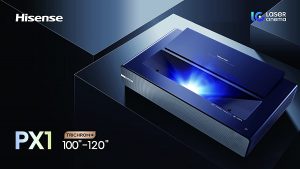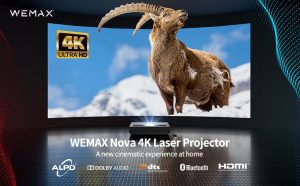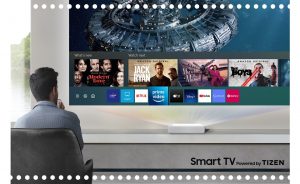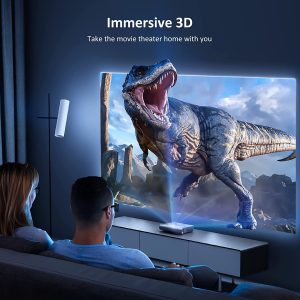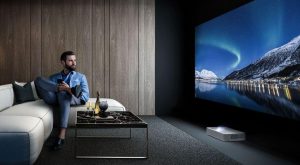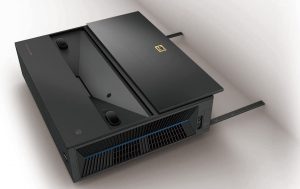Long rumored Xiaomi Mijia laser TV finally unveiled the mystery, the relevant parameters is clear in June 28, 2017 conference. Then this product is to bring us great surprise, or disappointed? Are we worthy of her? The first time to give you the most detailed Xiaomi Mijia laser TV evaluation and review, I hope you can make the choice by yourself.
Minimalist Housing Design

The appearance of Mijia Laser TV, still maintain the brand minimalist design concept. The body is mainly made of white plastic material, and the front is covered with black plastic net. The difference is that compared to the angular appearance of other projectors, the Mijia laser projection housing is more rounded.


This product uses the triangle bottom base, and the middle base is not adjustable, two rear bracket height adjustment can be carried out by the screw switch side, so as to realize the level and degree of physical products in the regulation of trapezoidal projection image.

The rear fuselage is the interface of the products, including three HDMI (one of which support ARC, can connect 7.1 surround audio speakers required), one USB 3.0, 3.5mm audio output, AV interface, audio output fiber and Gigabit ethernet. In order to facilitate daily use, Xiaomi also joined a USB 2.0 interface on the right side of the fuselage, to facilitate the daily connection of hard drives, peripherals and so on.
It is worth mentioning that there are two plastic baffles around the interface area, which are designed to conceal the existence of the fixed screws on the main board. In fact, the product supports the motherboard replacement, similar to the computer upgrade.
Since the lens life can be longer than 25000 hours, the single host and other accessories may be obsolete after one or two years, so the cost of replace projection is higher and more wasteful. Xiaomi said, the new motherboard is convenient for user to replace in the future. This upgrade mode, just like as Xiaomi TV split host upgrade design.

Above the fuselage is a projection lens, the left and right sides are infrared sensors. When the sensor senses an object near it, the camera will be lowered to low brightness immediately to ensure that the light is not harmful to the eye. Below the lens is the touch indicator switch.

In addition to the bottom of the three tripod feet, the product also includes a heat sink, two audio vents, four screws holes, installation of roof support. Audio, with a total of 30W two full frequency speakers and two high frequency speakers match. The bass uses low frequency guided phase tube used in Bose products, the audio has low frequency foundation without subwoofer sound.

Laser theater remote control layout similar to Xiaomi TV, but also the standard design of the 12 keys. The difference, in addition to the appearance of more echoes of white plastic products, the ring navigation key added like the apple iPod Classic, the “Click Wheel” roller design.
DLP, Five Color Wheel and ALPD 3.0
At present, the main imaging principles of projectors can be broadly divided into two kinds: 3LCD and DLP.
3LCD first divided the white light source into red green and blue three colors, the three color filtered to form image. When the tricolor light is split, the light of the liquid crystal molecule is adjusted to selectively filter the light at different positions to form a tricolor image, and the tricolor image is synthesized into a final color image.
DLP is divided into three beams and single type, can be understood as the principle about direct light in the DMD chip, DMD chip can automatically calculate what reflection are the different colors, put through a lens to form the final image.
Three DLP using three DMD chips, white light through a prism into RGB color light source after the three chip output color image, the combination has become the final image. Monolithic DLP is the use of rotation of the color wheel will divide the white light in time for red green and blue three colors, with a DMD chip, fast switching RGB image by visual color image forming residual feeling.
In the last two years, a new technology called LCOS has risen. In fact, this is an advanced version of LCD. LCD uses a liquid crystal panel to pass through the light source, and the LCOS uses the special silicon based liquid crystal to reflect the light source on the same structure.
At present, the technology of LCOS is not very stable, production can not keep up, so Xiaomi does not choose this way. As can be imagined 3LCD although the color reduction is more accurate, but the loss of light through the liquid crystal layer light is large, so although more vibrant colors, more accurate reduction of the overall picture of the brightness but it is difficult to ascend to a higher level.
And the projection has always been to see first, and say that the quality is good, so Xiaomi finally chose brighter DLP projection technology from TI.
In theory, the three chip DLP in brightness and color, are better than monolithic, but for now the three chip technology is difficult to achieve a very small volume, the product cost is high, all of these reasons, Xiaomi chose projection monolithic DLP core.
The above mentioned DLP brightness is advantage, color performance is lacking, mainly in the timing of three bonus green image, but the light energy of three kinds of color are not the same, and finally lead to the image color and elegant.
In order to solve this problem, Xiaomi first used the RGRGB refresh frequency color scheme. Officials say the results could boost the weak red light by 16% to 18%, allowing the gamut to cover more than 85% of NTSC.
The other uses Appotronics Corporation ALPD (Advanced Laser Phosphor Display) 3.0 Laser Projection Technology, which is to raise the intensity from the laser light source to further enhance the color, contrast and brightness performance of the screen.
Early projection uses light bulbs as light sources, and the life is too short to be eliminated. Later, the LED led was selected, but the same brightness and volume of the bulb could not be done, and then it was eliminated. Thus, the laser light source with higher light efficiency and concentrated angle is born. But white laser costs are too high, so blue laser + yellow silver powder has become the mainstream of the program.
In ALPD 3.0 technology using monochromatic laser + fluorescent powder special technical advantages: 1, high proportion of red light, the color gamut is larger, more accurate color reproduction; 2, brightness contrast is improved; 3, more uniform color, brightness uniformity, light source life has improved; 4. Since the release of the technology this year, many cinemas have been introduced.
The picture quality is higher than the general projection, but there is still a gap between LED TV under the strong light environment
Mijia home laser theater using ultra short concave mirror lens, the product close to the wall, you can cast about 50 inches of pictures. And want to cast 150 inches of picture, just need to be projected and be apart from the projection screen wall 50 cm distance.
This product uses a large depth of field lens in Japan Ricoh, 30 inch screen size range changes, equipment to re focus automatics, and not like other ordinary projector as slightly move ,the focus is lost.
Officials said the maximum brightness could reach 5000 lumens, with a static contrast of 3000:1. Actually, the brightness is not so high, only about 1200 ANSI Lumens, below JmGO S1 Pro which up to 3000 ANSI Lumens with 5000:1 contrast rate. So, maybe JmGO S1 Pro is the best Laser Projection TV until now, and Mijia Laser TV is the cheapest.
Due to time constraints and the future and the use of specialized equipment to verify the above data is accurate, we use some test diagram for quality testing, pay attention to the following are simulated daily use of the environment, rather than the laboratory test environment.
Test environment for daytime, turn off lights and draw curtains. The projected picture size is about 50 inches.
First, you can see that in the case of light ON, the image content can be clearly identified, but the image quality is affected.
After turning off the lights, using the test video, you can find bright colors, visual perception quite like ordinary LED TV, relatively bright, especially red performance dazzling.
From the 4K TV resolution test chart, Mijia Laser TV supports FullHD.

In contrast, the problem of poor shadow detail exposed. The shadow layer test chart, the lower left in the dark level when the size is about 14, and 8 of the standard still have some gaps. If the screen size is adjusted to 150 inch, shadow detail will drop to 16 or even 18 of the standard.

The accuracy of color restoration is higher than expected. Except for the slight difference between green and yellow, other basic accuracy. This performance even more than a lot of flagship LED TV.
Here are some landscape maps to test the quality of the laser cinema.
This sunset picture, color is smooth and there is no faulting occurred.
In the fruit test chart, the red and green difference is obvious, this performance is better than the ordinary projector, but has the disparity with the liquid crystal display screen.
The star test pattern, shadow detail loss is more serious, many places can only see the stars, the surrounding nebula details are lost.
The delay of the input signal is about 88ms.
Connecting to the PS4 console, the control will not delay, even if the game requires more accurate FPS game, there is no delay affecting the game experience.
In this backlight image, shadow detail missing the more obvious, if the screen up to 100 inches or more, the situation will be more obvious.
When using a soccer test video, although the picture does not exist trailing, but because the product is not equipped with MEMC and other related motion compensation technology, in football or athletes high speed movement, the picture is slightly inconsistent.
Finally, although the highest resolution projection is 1080p, but Mijia Laser TV supports H.264 and H.265 encoding 4K video analytical, drag the progress does not appear obvious Caton wait for the situation.
In terms of sound effects, the speaker comes with a clear level of pitch and good performance for high frequencies and vocals. The bass is not as strong as the individual subwoofer, but there is no problem of bass weakness.
Integrated Xiaomi TV box
Mijia laser TV in the software completely quoted Xiaomi TV style, not to speak to much in the function and content richness, this part of the main explanation for the projector optimization differences.
Long press the remote control will pop up the shortcut settings menu, including focus setting and Trapezoidal rectification.
Focus adjustment need not be too much detail, through the left and right button, adjust the text to be clear.
Trapezoidal rectification should be emphasized, and the Mijia laser cinema provides two ways to adjust including the physical tripod and the software. The correct way is to reset the software, then adjust the height of the left and right physical feet so that the projection screen can become rectangular as much as possible. If you can’t adjust it by physical method, then choose the software adjustment. Mainly because software adjustments sacrifice image resolution.
In addition to focusing, trapezoidal correction, but also contains brightness, image parameters and projection mode.
Brightness mode is divided into three, the standard mode is the default mode. Cinema mode give priority to the accuracy of color reproduction, highlighting pattern mode that give priority to brightness and contrast of images.
The image parameters are similar to the TV side, and can be imagined as software quality tuning.
Projection method can be adjusted according to the product ceiling, etc..
In addition, Bluetooth and peripherals interface, you can see the current Xiaomi equipment which can be used on this products. At present, the basic Xiaomi TV available accessories, Mijia laser TV also can be used.
Summary
As far as this product is concerned, in the absence of interference from ambient light, the picture quality can be basically comparable to that of the midrange or even high-end TV. When light interference is strong, although the image quality loss is relatively serious, but still can see the content. Under the same lighting condition, the ordinary overhead projector is already out of sight.
As a whole, the quality of Xiaomi Mijia Laser TV is much better than that of an ordinary home projector, but it still can’t resist the interference of ambient light.
There are 1080P signal output, 150 inches, 2.5 meters away to watch, and there will be no obvious image of the particles. But closer to see, it will not clear than 4K TV. Generally speaking, it is enough for the majority of people to watch TV at present.
Finally, of course, for better quality effects, you can buy the white projection screen. Otherwise, the projection wall should be white and smooth.












